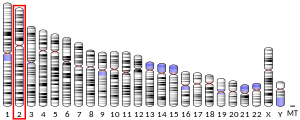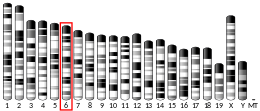KDM3A
Appearance
Lysine demethylase 3A is a protein that in humans is encoded by the KDM3A gene.[5]
Function
[edit]This gene encodes a zinc finger protein that contains a jumonji C (JmjC) domain and may play a role in hormone-dependent transcriptional activation. Alternative splicing results in multiple transcript variants. KDM3A catalyzes the demethylation of H3K9me1 and H3K9me2 residues. Its function is dependent on the presence of cofactors Fe(II) and α-Ketoglutarate.[6]
References
[edit]- ^ a b c GRCh38: Ensembl release 89: ENSG00000115548 – Ensembl, May 2017
- ^ a b c GRCm38: Ensembl release 89: ENSMUSG00000053470 – Ensembl, May 2017
- ^ "Human PubMed Reference:". National Center for Biotechnology Information, U.S. National Library of Medicine.
- ^ "Mouse PubMed Reference:". National Center for Biotechnology Information, U.S. National Library of Medicine.
- ^ "Entrez Gene: Lysine demethylase 3A".
- ^ Yamane K, Toumazou C, Tsukada Y, Erdjument-Bromage H, Tempst P, Wong J, Zhang Y (May 2006). "JHDM2A, a JmjC-containing H3K9 demethylase, facilitates transcription activation by androgen receptor". Cell. 125 (3): 483–495. doi:10.1016/j.cell.2006.03.027. PMID 16603237. S2CID 6643329.
Further reading
[edit]- Wellmann S, Bettkober M, Zelmer A, Seeger K, Faigle M, Eltzschig HK, Bührer C (August 2008). "Hypoxia upregulates the histone demethylase JMJD1A via HIF-1". Biochemical and Biophysical Research Communications. 372 (4): 892–897. doi:10.1016/j.bbrc.2008.05.150. PMID 18538129.
This article incorporates text from the United States National Library of Medicine, which is in the public domain.




